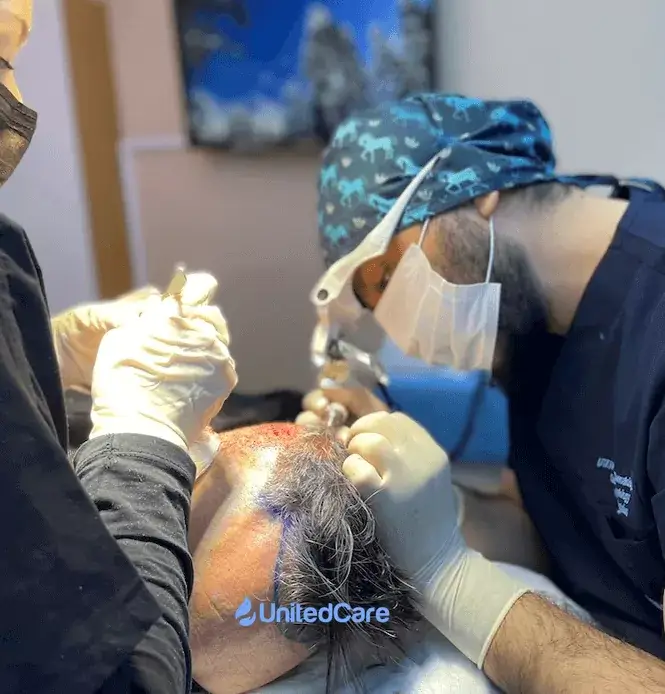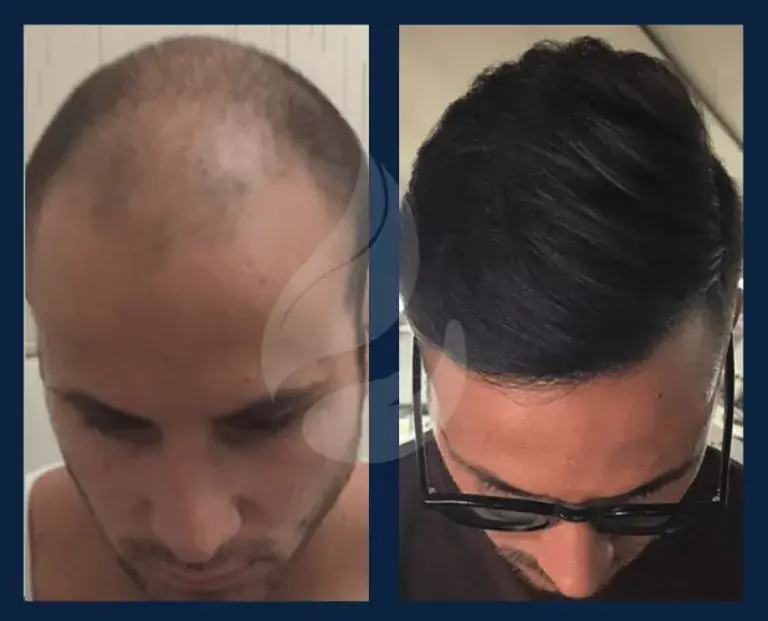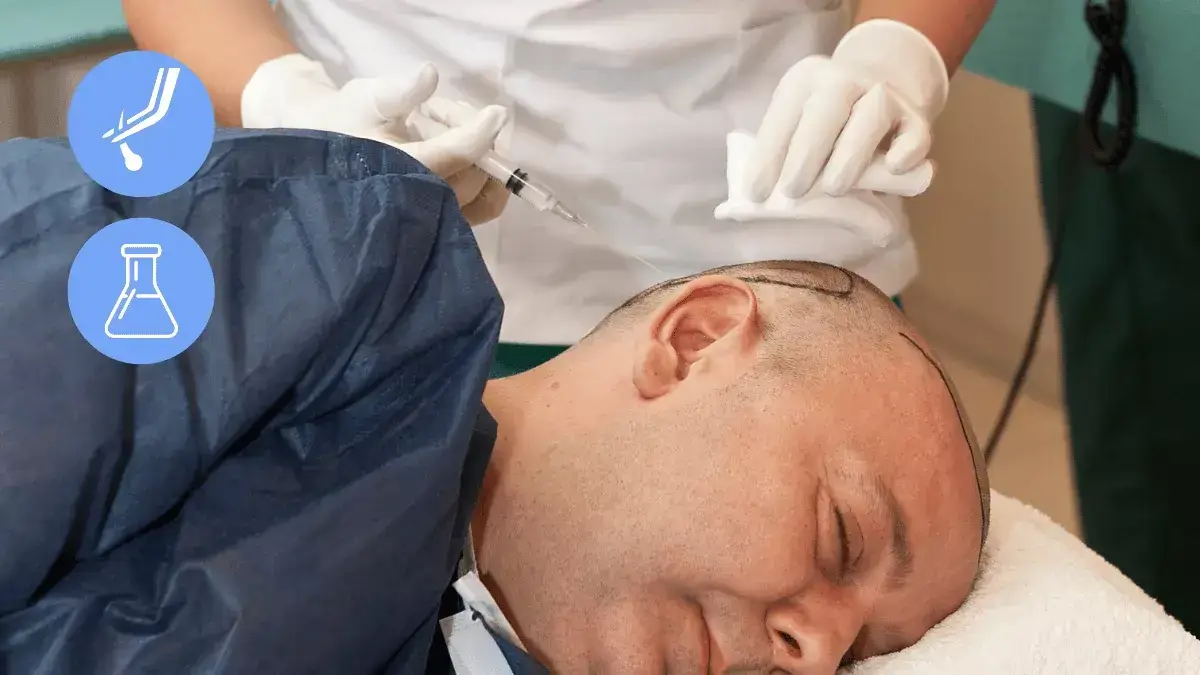TL;DR
➡ Yes, hair transplant surgeries do contain a potential for pain. But that is precisely why we have anesthesia.
➡ To keep its effect active and avoid any potential for pain, anesthesia is given multiple times in different stages throughout the surgery.
➡ Furthermore, depending on your preference, you will have different anesthesia options.
➡ Ultimately, it is natural to expect pain, at least after the surgery. However, you will have painkillers to deal with that as well.
Having a hair transplant surgery will mean that you are going to fall under the knife.
It is an important step and decision in your life, so we better ensure that it goes as smoothly and effectively as possible.
And considering that even deciding on getting this surgery was difficult, you now learn that you might experience pain because of it too?
Luckily, the wonders of modern science protect our patients from this instance as well. Yes, hair transplants come with minor physical discomfort, but they are not painful.
Why?
Simple: Anesthesia.
In a hair transplant, every experienced dermatosurgeon uses adequate amounts of anesthesia spread around the different stages of the surgery to minimize your pain by numbing your muscles.
Ultimately, thanks to the anesthesia, your hair transplant experience goes without suffering extreme amounts of pain. So to prove and explain that to you, I will go over the different stages of a hair transplant in which anesthesia is used:
Table of Contents
Let’s go over the stages of the surgery process one by one:
What to Expect During Different Stages of the Surgery
Many patients believe that a hair transplant is something you experience in a single surgery, and after it is done, you have your great outlook restored with nothing more to do.
This is entirely false. A hair transplant’s success or failure is defined by how much of your transplanted hair sticks around rather than falling shortly post-surgery. So, ideally, we highly value the pre-surgery and post-surgery checkups too.
That includes starting to use an anesthesia at an early stage and sticking to it late after to prevent you from experiencing pain:
Pre-surgery
During the pre-surgery process, your clinic will give you a consultation about your anesthesia options. This consultation is primarily for your comfort during the surgery and the effectiveness of the sedation medication.
During pre-surgery, your doctor will determine and offer options based on the ideal hairline for your surgery. These options usually can be the usage of local anesthesia, such as sedative tumescent anesthesia, or using sedation altogether, which will require an anesthesiologist to be present in your clinic and cost more.
If you choose local anesthesia, your doctor, preferably an expert dermatologist, will use a needle-free dermojet during the implementation of anesthesia to further reduce any uncomfortable feelings. Alternatively, if you choose sedation, your clinic’s anesthesiologist will help you gently fall asleep during the surgery and help the surgery run smoothly. After you have decided on an option along with your doctor based on your medical background, preference, and the ideal hairline, the first phase for numbing your muscles will begin:
Harvesting Stage

The process of numbing your head muscles is done in two parts:
1️⃣ Numbing the donor area where we take the grafts from during the harvesting stage.
2️⃣ And numbing the recipient area where we will transplant those hair grafts during the implantation stage.
In the first stage, we begin by injecting your chosen anesthesia into the donor area and numbing your muscles. Alternatively, the anesthesiologist is present for your sedation. Once the scalp is numb, you will feel nothing throughout the process. This numbness will last approximately 3 hours.
Thanks to the needle-free dermojet, the injections are quick and small, and that is why the pain you experience during the injection will be minimal. Most patients do not even see this feeling as worse than a fly bite that is quickly followed by numbness as the medication kicks in. After you are injected, you can feel your muscles get completely numb within seconds to minutes.
After the graft extraction, there is time for the storage phase and a lunch break. Your follicles are stored for later use at this phase. When the lunch break is over, the final implantation stage starts:
Implantation Stage
This time, local anesthesia is applied (if you haven’t chosen sedation by the anesthesiologist) to the hairline and crown recipient zones. The overall process, however, goes the same as the harvesting stage.
We move on to the second stage of numbing your scalp and start the implantation stage.
Using the needle-free dermojet, we re-implant the harvested and stored follicles into the balded areas. The worst pain you can potentially feel here, unless you have chosen sedation by the anesthesiologist, in which case you will not even feel that, is the discomfort of sitting in the same place for a long time.
⚠️ Thanks to the supportive anesthesias, you are not expected to feel any pain during the surgery, but if you do, simply inform the staff, and your doctor will inject more medication to ensure your scalp muscles are numbed.
Pain After a Hair Transplant Surgery
Now that your surgery process has passed without pain let’s discuss whether you might experience pain after a hair transplant.
The first few days after the surgery, during the initial healing, you will feel temporary pain and overall discomfort around your scalp, as it is the most common side effect of a hair transplant.
But painkillers are prescribed especially for this period, so you will not experience much during these days. After the first 2 to 3 days pass, you will not even need painkillers.
Once you’re off the painkillers, you should still expect minor pain and discomfort, but it is very mild for most patients.
⚠️ If the pain persists, however, you should see your doctor immediately, and with their consultation, you can continue using over-the-counter painkillers.
In short, it is natural to expect some pain after a hair transplant surgery, but that is why we have painkillers. And as long as you take them regularly as your doctor has instructed, you do not have to worry about experiencing pain.
So, do hair transplants hurt?
So, is a hair transplant painful? No.
Thanks to local anesthesia (or the sedation that an anesthesiologist uses), needle-free dermojet, and post-surgery pain medications, a hair transplant process goes without experiencing any pain in the long term.
💡 However, no surgery can be completely painless, and some brief and likely temporary discomfort is always present and possible.
To ensure that your hair transplant surgery is a pleasant and easy experience, for the most part, you must make the right decision in choosing the right clinic with an expert dermatologist at the site:
This is where we come in:

At UnitedCare, we begin your hair transplant process by offering you a one-on-one consultation with our expert doctors and dermatologists to find the best-suited option together. We will answer your questions regarding the surgery process and potential pain here.
Furthermore, our expert doctors check your scalp’s health and medical background during the consultation to decide which method suits you most. After you have decided on a technique, we begin the treatment with the utmost attention. But most importantly, we stay in contact with our patients even long after the treatment has already finished ensuring that the surgery succeeds in becoming a permanent one.
If you believe it is the right time to search for the correct method to bring back your shining hair to its deserving place, you can schedule a free call immediately. Regardless of which way you choose, one policy in our clinic stays the same.
We value creating a balance between your comfort and your health.
With the right clinic, you can avoid pain and guarantee success.
You can have both and restore your natural look with a Dermatosurgeon at UnitedCare:
Frequently Asked Questions (FAQs)
Will I feel pain during the surgery?
No, there will not be pain. Although some discomfort is possible during the different stages of a hair transplant, we have a solution for that: Anesthesia. During your hair transplant surgery, based on your preference, you will be given different options for how the anesthesia should be administered. The most common ones are local tumescent anesthesia that can be injected with a needle-free dermojet to reduce your pain sensation even further or outright choosing sedation from an anesthesiologist. In either case, you will be administered the necessary amount of anesthesia in two different stages of the hair transplant (harvesting and implementing phase), which will keep the numbness of your muscles high at all times. Ultimately, the most discomfort you will ever potentially feel will be no longer than a fly bite, and you will not feel pain.
Will there be pain after the transplant?
Technically yes, but not too much. Some amount of pain is expected after a transplant, but even that is entirely manageable with painkillers. The most common side effect of every hair transplant surgery is that patients slowly start to feel pain around their scalp after the anesthesia medications used during the surgery pass. That is why every clinic prescribes their patients with potent painkillers to be used after the surgery process ends. If you follow your doctor’s instructions on how often you should take your painkiller medications, you will not experience pain even after the transplant.
How long does the pain last after a hair transplant?
The pain that persists even after the hair transplant surgery is expected to last 2 to 3 days. For this instance, your chosen clinic will prescribe you a potent painkiller medication to erase this pain. After those few days pass, you will not even need painkillers. It is natural for minor pain to persist even a little longer, but if you feel that there is still an unbearable amount of pain, you should contact your doctor immediately. That way, with their consultation, you can continue using your instructed painkiller medication for a little while until your doctor seems fit to stop using it.

